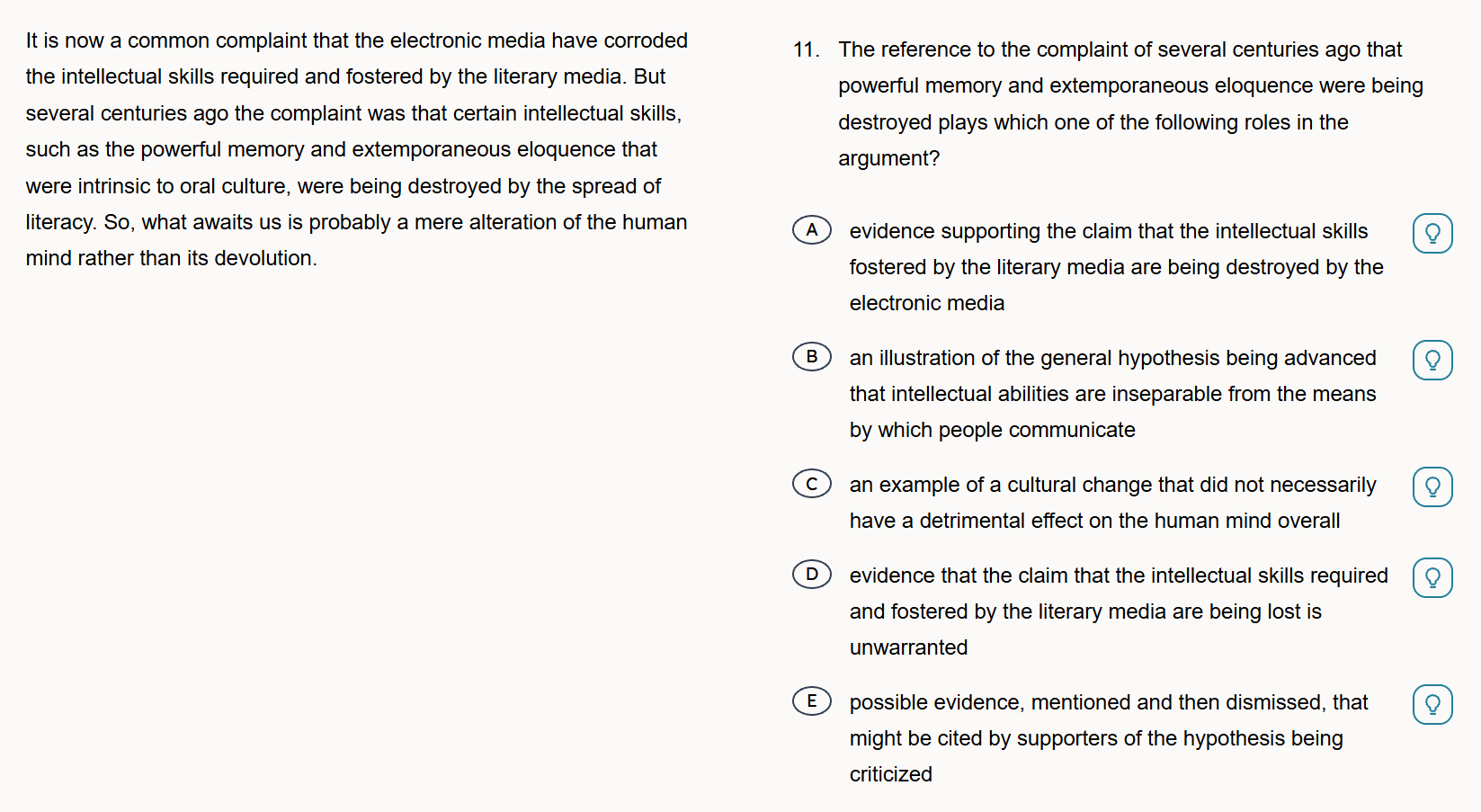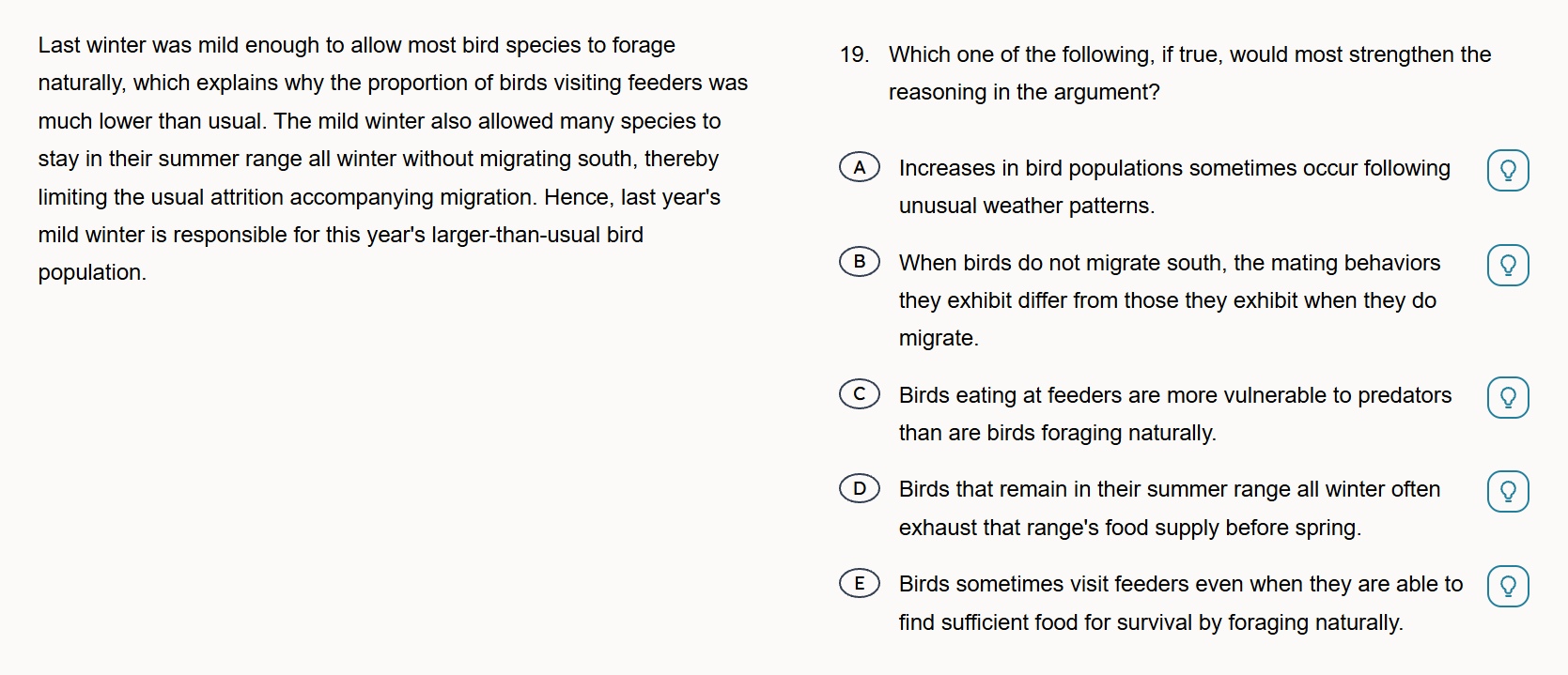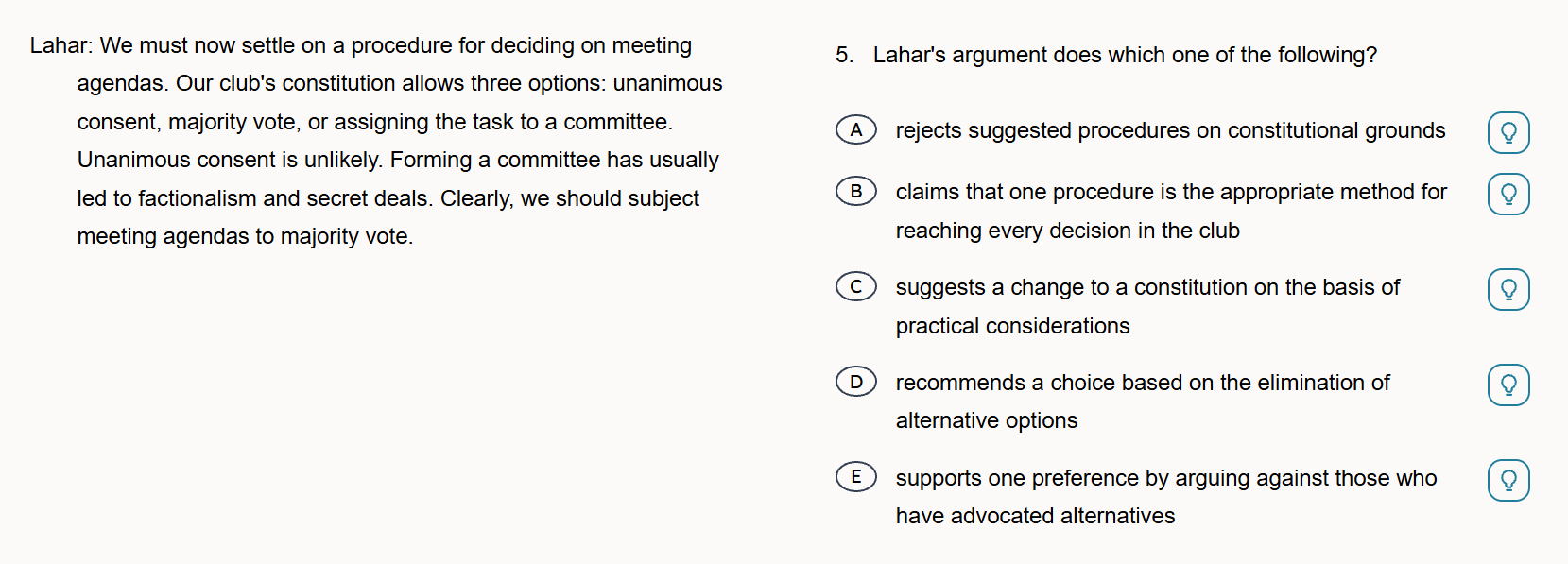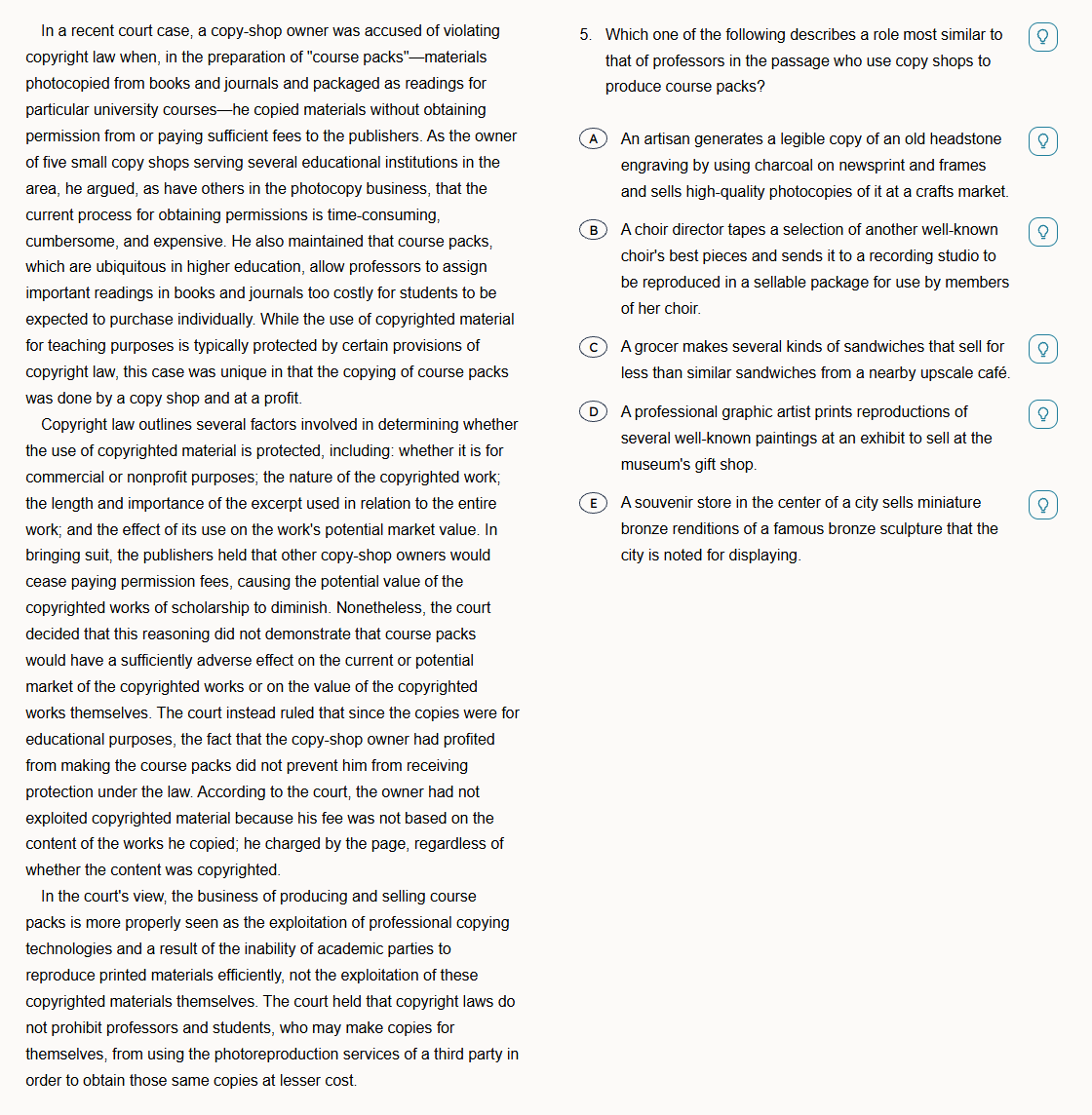Sample LSAT Questions
The LSAT has four sections split between two types: Logical Reasoning (LR) and Reading Comprehension (RC). In this post, we’ll walk you through questions from both, explain what they test, and give you plenty of practice questions to try for yourself.
Already know what the questions look like and want to get right to the free practice questions?
Anatomy of a Logical Reasoning (LR) Question
Let’s look at a real LR question:
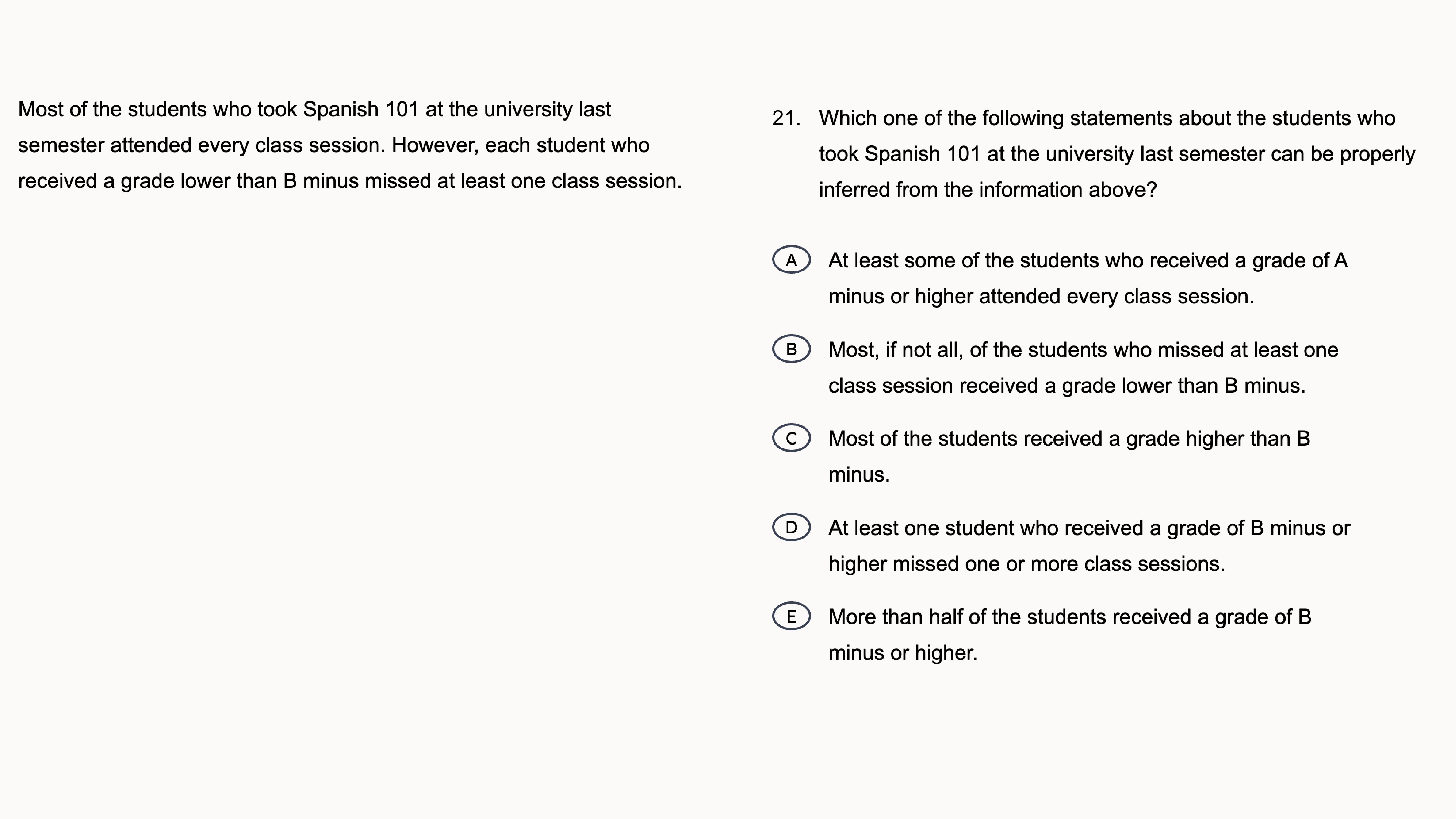
This question, like every LR question, has three parts:
- A brief passage on the left
- A question at the top right
- Five answer choices down the right side
Let’s look at each of these parts in more detail. We’ll start with the brief passage on the left. We call this passage the stimulus.
The Stimulus
The stimulus is a series of claims that you’ll need to analyze. Sometimes, like in the example above, the claims are simply presented as a set of facts.
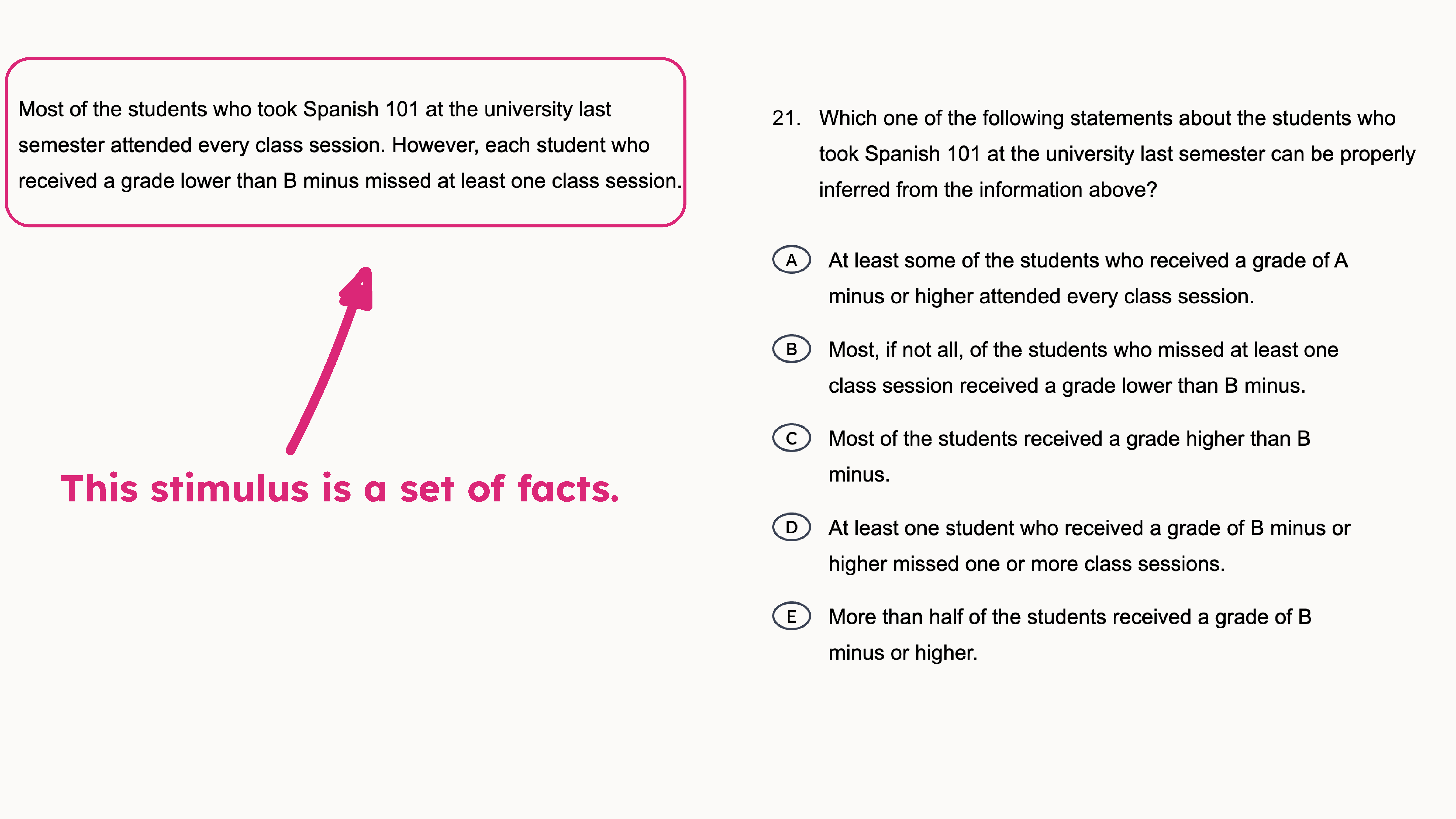
The claims in the stimulus won’t always be a neutral set of facts, though. Often, they’ll form an argument designed to lead to a certain conclusion, like below:

Here, the stimulus presents us with an argument meant to persuade us that, in the marketing consultant’s words, “the advertising campaign was ill conceived.”
Speaking of the marketing consultant, note how this stimulus begins by telling us who’s speaking. In LSAT terminology, we call that source “the author.” Sometimes the author is not identified. Other times, as in this example, the stimulus will identify the author to give us extra context and help us understand the scenario.
Occasionally, the stimulus will even have multiple authors, like this:
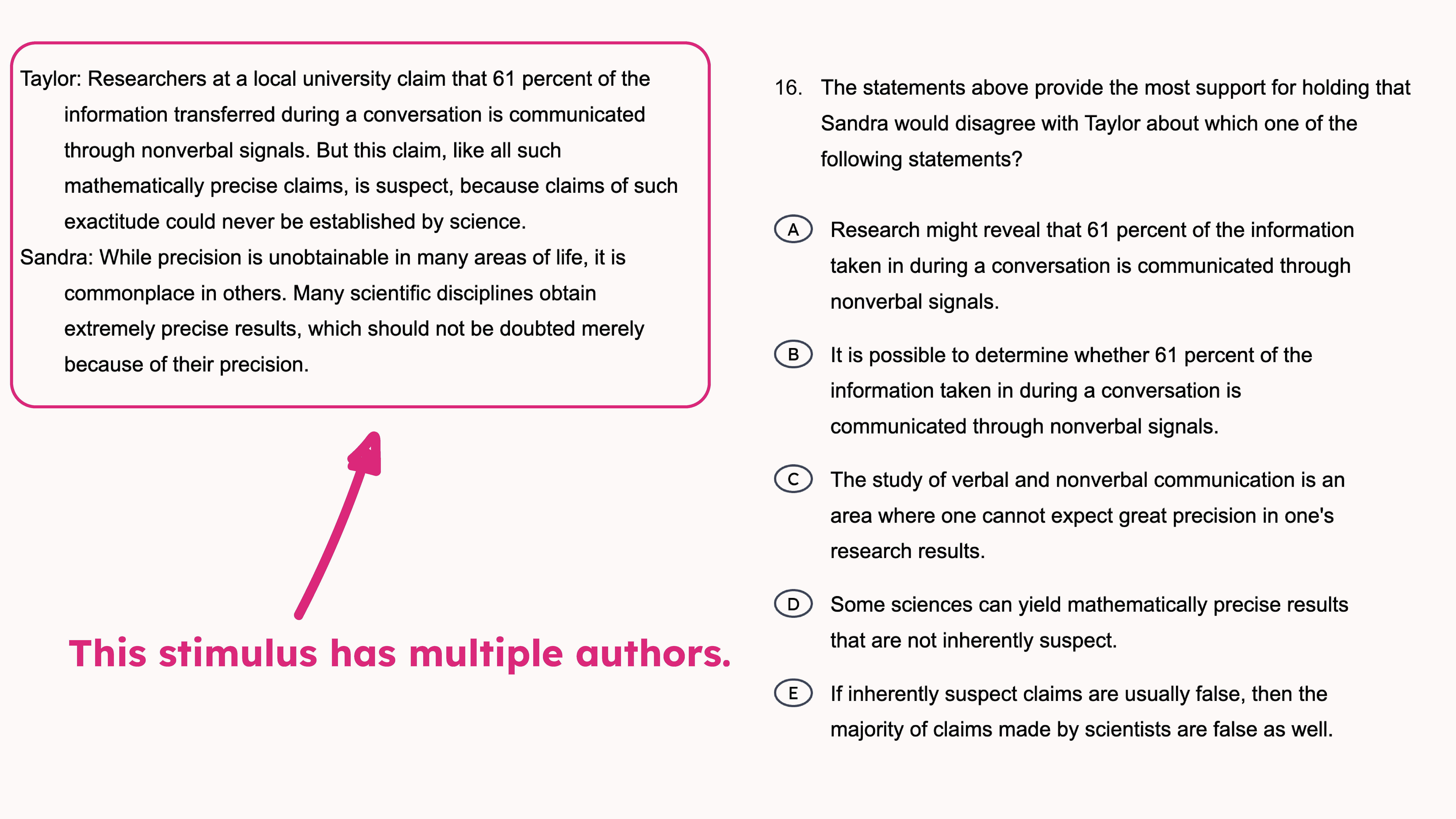
In this case, the authors’ names don’t give us any clues about what to expect. The names are there to make it clear that this is a conversation between two people and to let us reference each set of claims.
To sum up, the stimulus is always a set of claims that we’re required to analyze. It might be a series of neutral facts or it might be an argument designed to persuade. It might have an implicit author, a single named author, or two named authors. In every case, though, our task is going to be to assess those claims in some way.
How we go about assessing them depends on the question stem.
The Question Stem
The text at the top right of the page is the question stem. It poses a question about the stimulus. It’s the thing we need to answer.
The test can pose a wide range of questions about a stimulus, but they all have one thing in common: they test you, in different ways, on how a set of claims can (or can’t) be used to support a given conclusion. Sometimes, the question stem will have you drawing conclusions yourself, like in the Spanish 101 example, where the question stem asks us what can be “properly inferred” (a fancy way of saying “concluded”) from the facts in the stimulus.
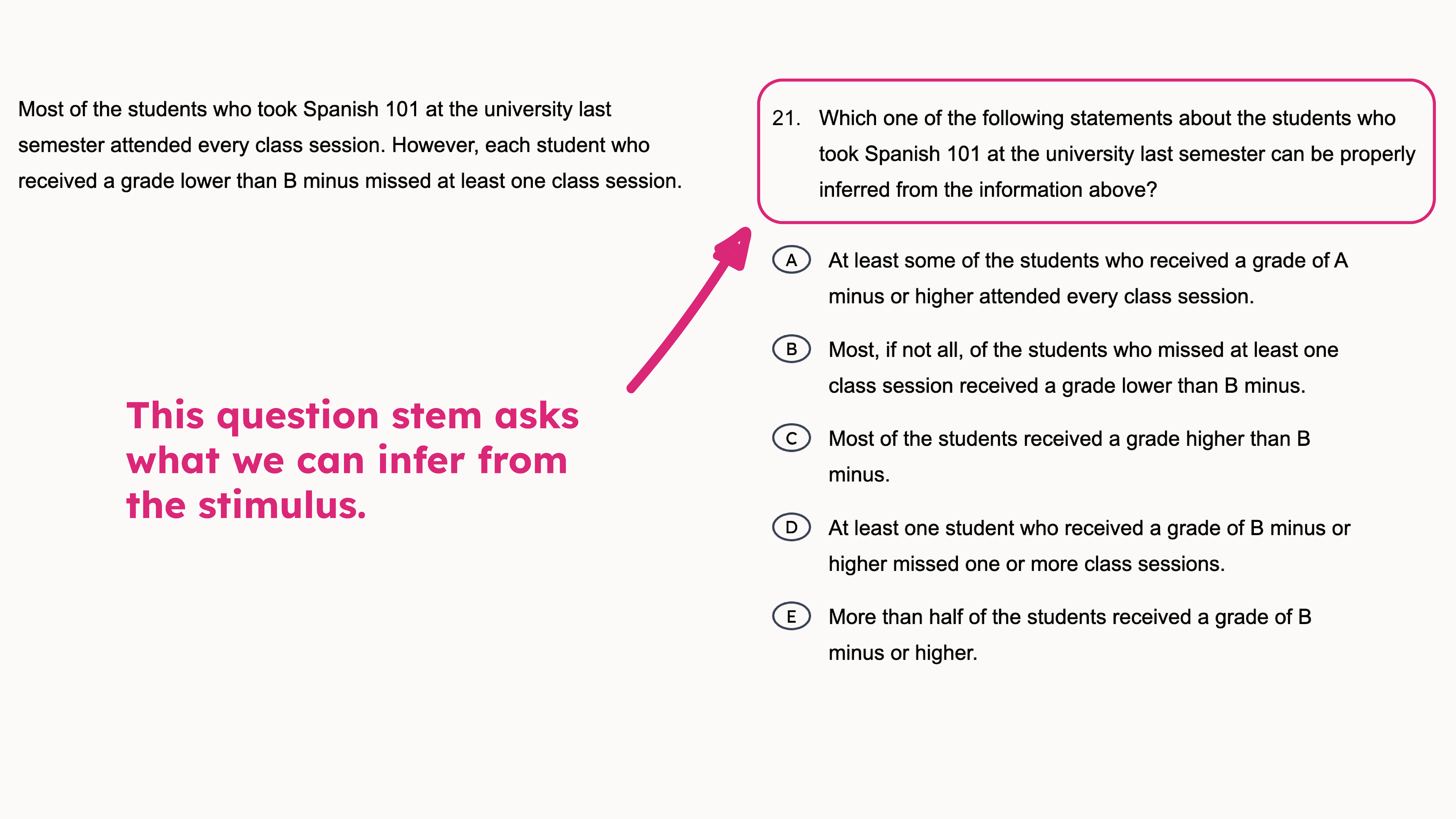
Other times, when the stimulus features an argument, it’s the author who’s attempting to draw some conclusion from a set of supporting claims. In these cases, your job will be to scrutinize the reasoning underlying that argument.
For example, in the question with the marketing consultant, we’re asked to describe how the argument is “vulnerable to criticism,” or in other words, how the author uses flawed reasoning to reach her conclusion.

When the stimulus has multiple authors, the question stem often asks us to use their claims to draw a conclusion about what, precisely, the authors agree or disagree on. In the example with Taylor and Sandra, we’re asked to identify the point of disagreement.
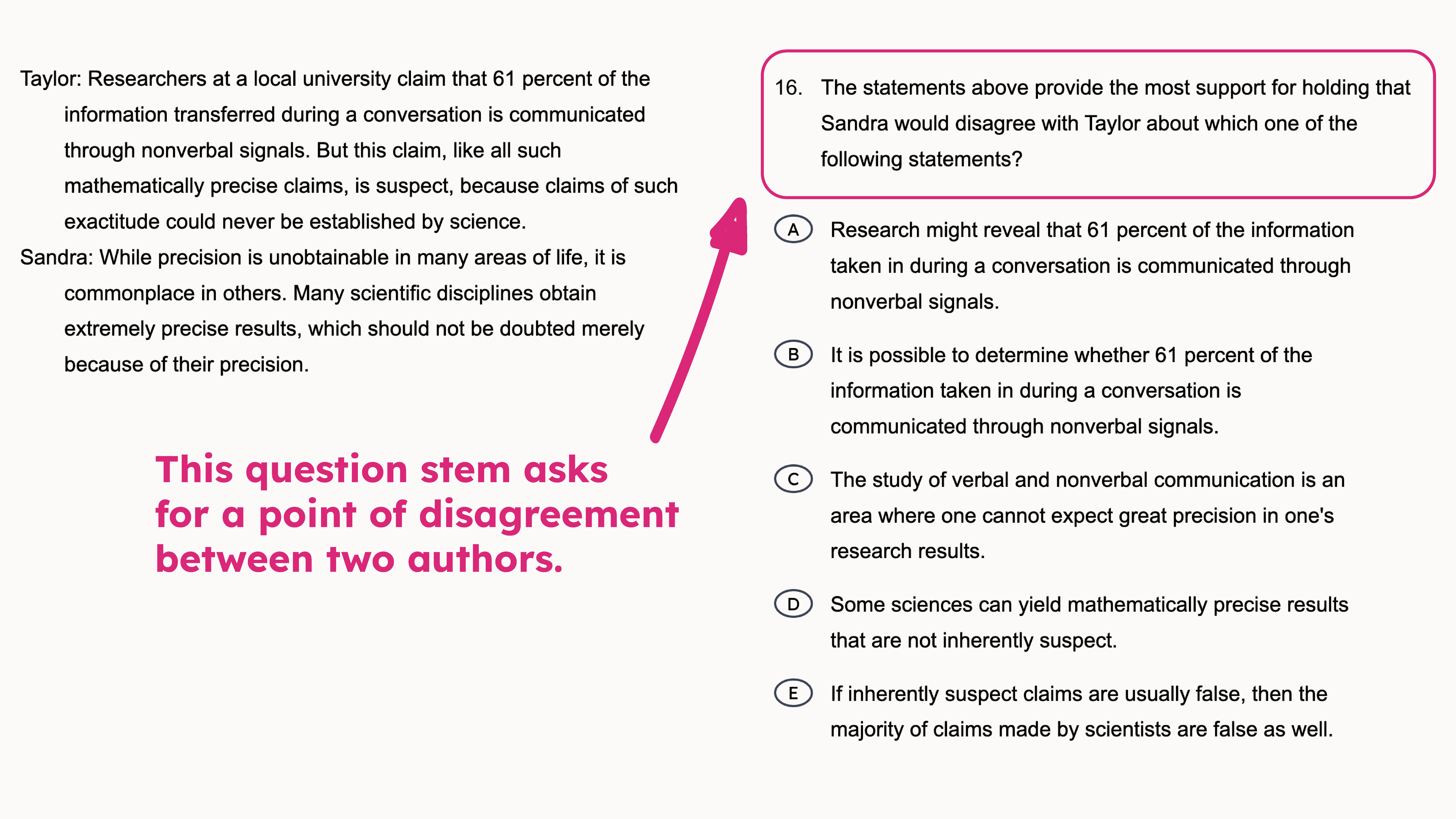
All told, there are 17 different types of question stem. They all boil down to questions about how certain claims support certain conclusions.
Once we’ve read the question stem and considered the claims in the stimulus, all that remains is to choose one of the answer choices.
The Answer Choices
Every LR question has five answer choices listed from (A) to (E).
On some questions, it might seem like more than one of the answer choices are correct. Don’t be fooled. There is only ever one right answer. At the end of the day, our job is to find the right answer and avoid getting duped by the other four.
Sometimes two choices look equally correct because they’re saying the same thing in different words. If that’s the case, you can cross them both off. Since there’s only one correct answer, any duplicates must be wrong.
More often, though, you’ll find that two attractive answer choices will have different meanings. When that’s the case, it means you’ve misread or misunderstood something, either in the stimulus or in the answer choices themselves. Reread each one and get clear on what, precisely, they’re saying. Consider whether you’re adding any of your own assumptions to make either of the answer choices “work.” Reading with precision and being aware of your assumptions are the best ways to tell a wrong answer from a right one. If that still doesn’t work, you should simply make a call: choose one of the answers, flag the question, and move on. Wasting a lot of time on a question is worse than getting it wrong. Come back to the question after you’ve answered everything else. Sometimes a fresh look is enough to catch a key detail you’d missed the first time around.
Try Some Sample Logical Reasoning (LR) Questions
Want to see some more examples of LR questions? Try your hand at the questions below to get a feel for each of the different question types.
You’ll likely find that some questions are easier than others. In part, this is because different people are naturally better or worse at different question types. But there’s no inherently “hard” or “easy” question type. The LSAT can make any question type as hard or as easy as it likes.
Anatomy of a Reading Comprehension (RC) Question
Now let’s take a look at the other category of LSAT question: Reading Comprehension (RC).

Right off the bat, we can see that the passage on the left is much longer than an LR stimulus. This is the Reading Comprehension section, after all, so naturally the LSAT gives you a lot to read.
Or does it?
Each RC section only requires you to endure four passages. For each passage, you’ll answer a series of five to eight questions about the content of that passage. If you were to split a passage up into five to eight equally sized portions and divide those smaller portions among the questions, you’d find that those passage portions are a very similar length to an LR stimulus. So RC questions don’t actually make us read more than LR questions do. For RC, we just need to do more of the reading up front.
Besides the long passage, the rest of the question page is quite similar to an LR question. You have a question stem in the upper right and a set of five answer choices. Let’s look at each in a little more detail.
The Passage
No fancy “stimulus” lingo here. We just call the passage “the passage.” (If only everything about the LSAT were so simple.)
RC passages pull from a wide range of subject matter including law, the humanities, and the natural and social sciences. You’ll see passages about UN treaty guidelines, jazz musicians, black holes, and the economics of video games. Pretty much anything is on the table. But you’re not expected to have any background knowledge about the topic at hand. Anything you need to know about subject matter in the passage will be told you by the passage. Your job is to understand what, precisely, the passage is telling you.
Most passages are by a single author who’s trying to make a point. That point might be that certain UN treaty guidelines are flawed and need improvements. Or it might be that a notable jazz musician is misunderstood by his critics and should be reexamined in a different light.
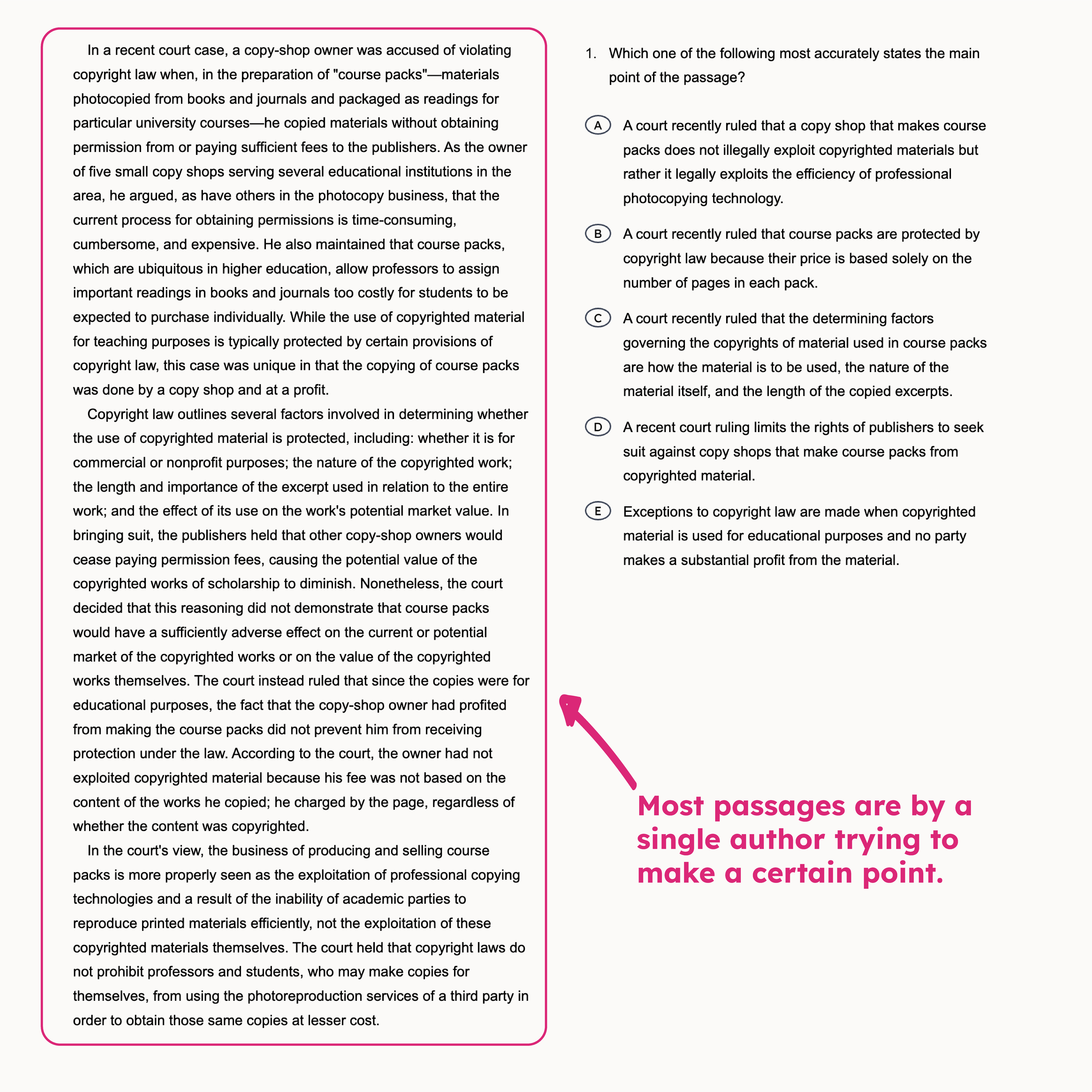
Some passages, though, are by two different authors. Each RC section includes one comparative reading passage split into two mini-passages by separate authors. They pose the extra challenge of keeping track of what each author has to say.
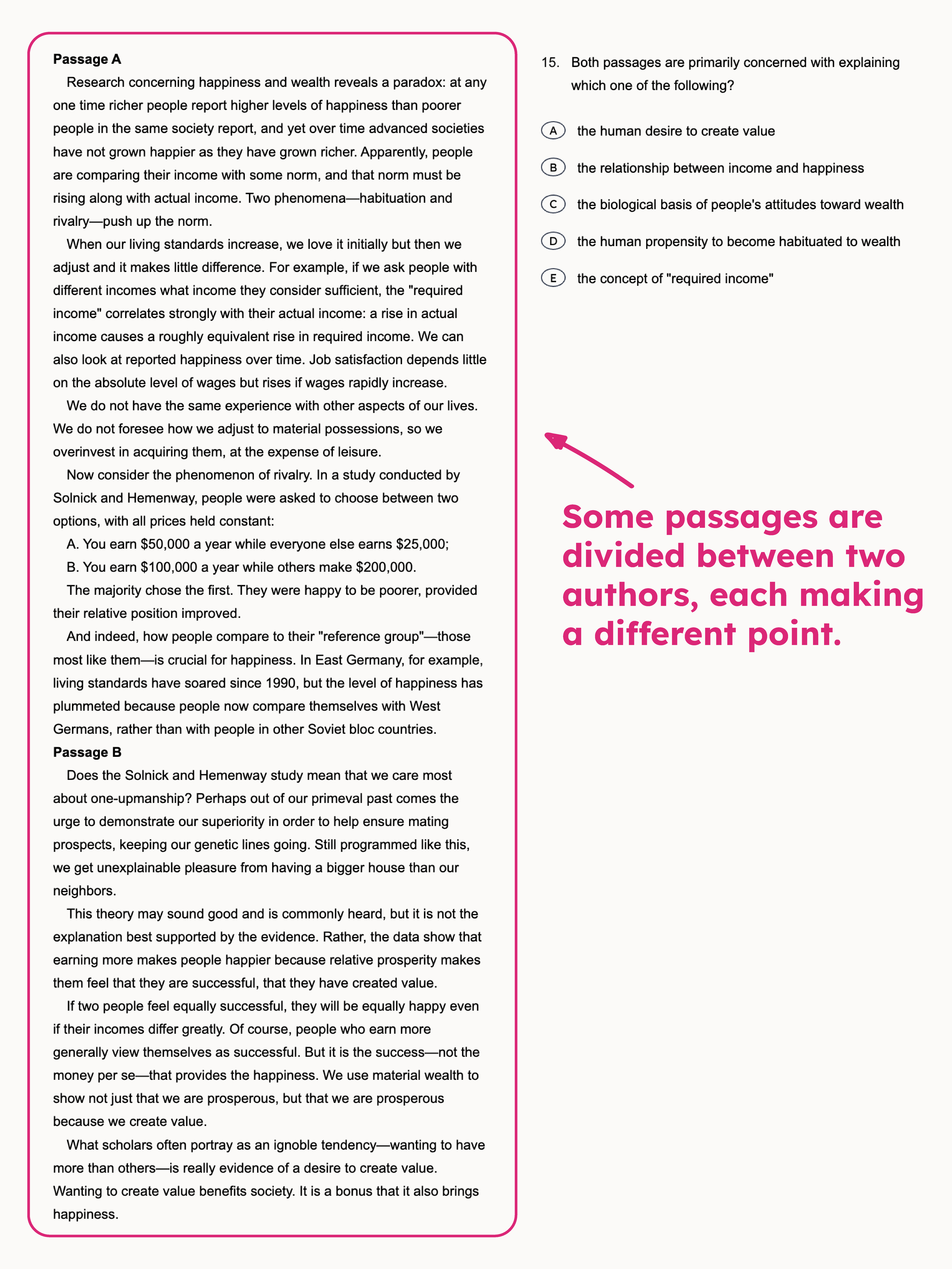
Whichever kind of passage you’re presented with, you’ll be given a series of questions related to that passage. As with LR, the objective of each question is given by the question stem.
The Question Stem
The text at the top right corner is the question stem. It poses a question to test your understanding of the passage material. It might ask you about the author’s overall main point, like in the example below.
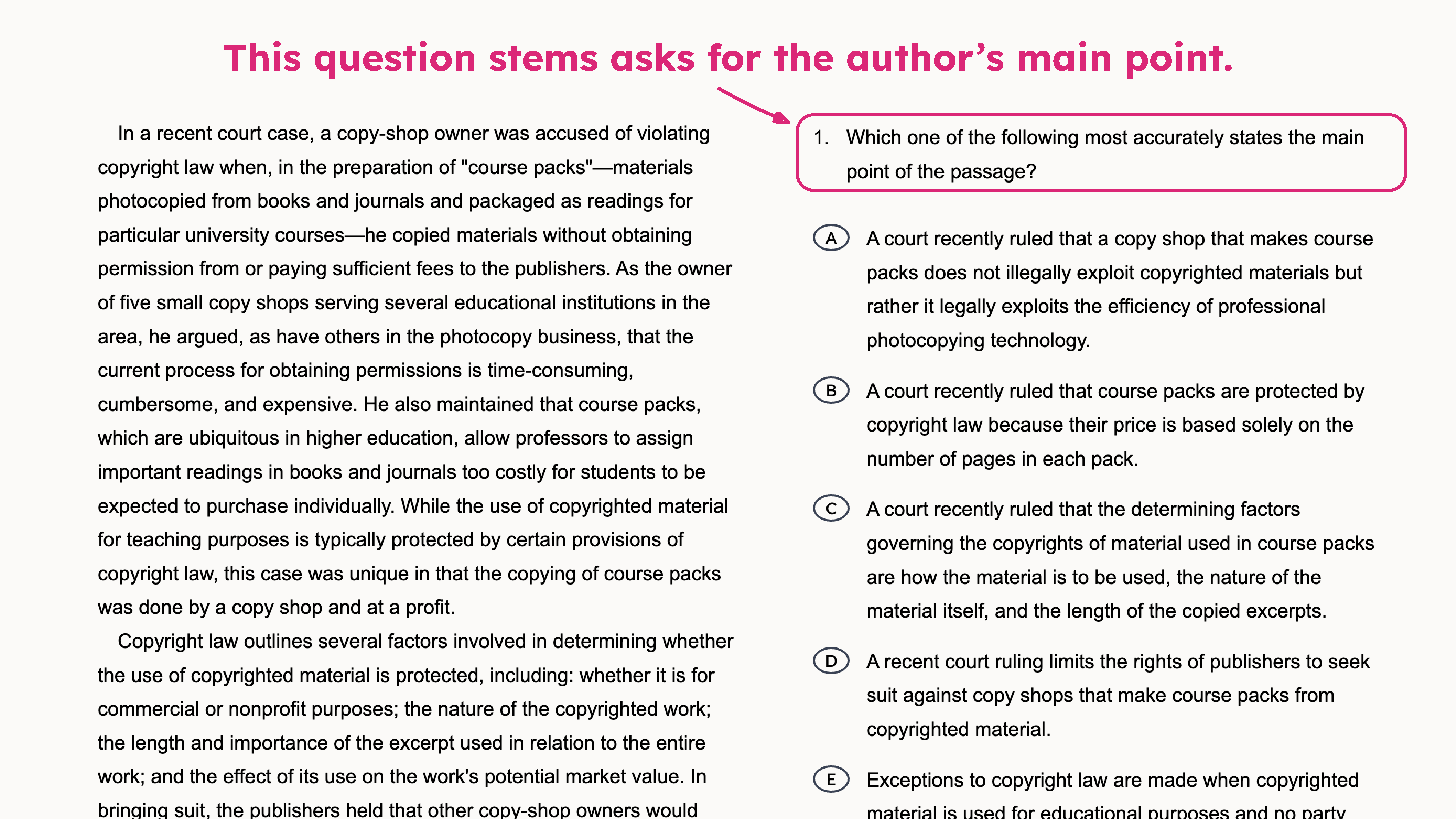
Sometimes, the question stem will ask you for information that’s directly stated in the passage. Many times, though, you’ll be asked about things that aren’t stated outright, only implied by the author’s claims.
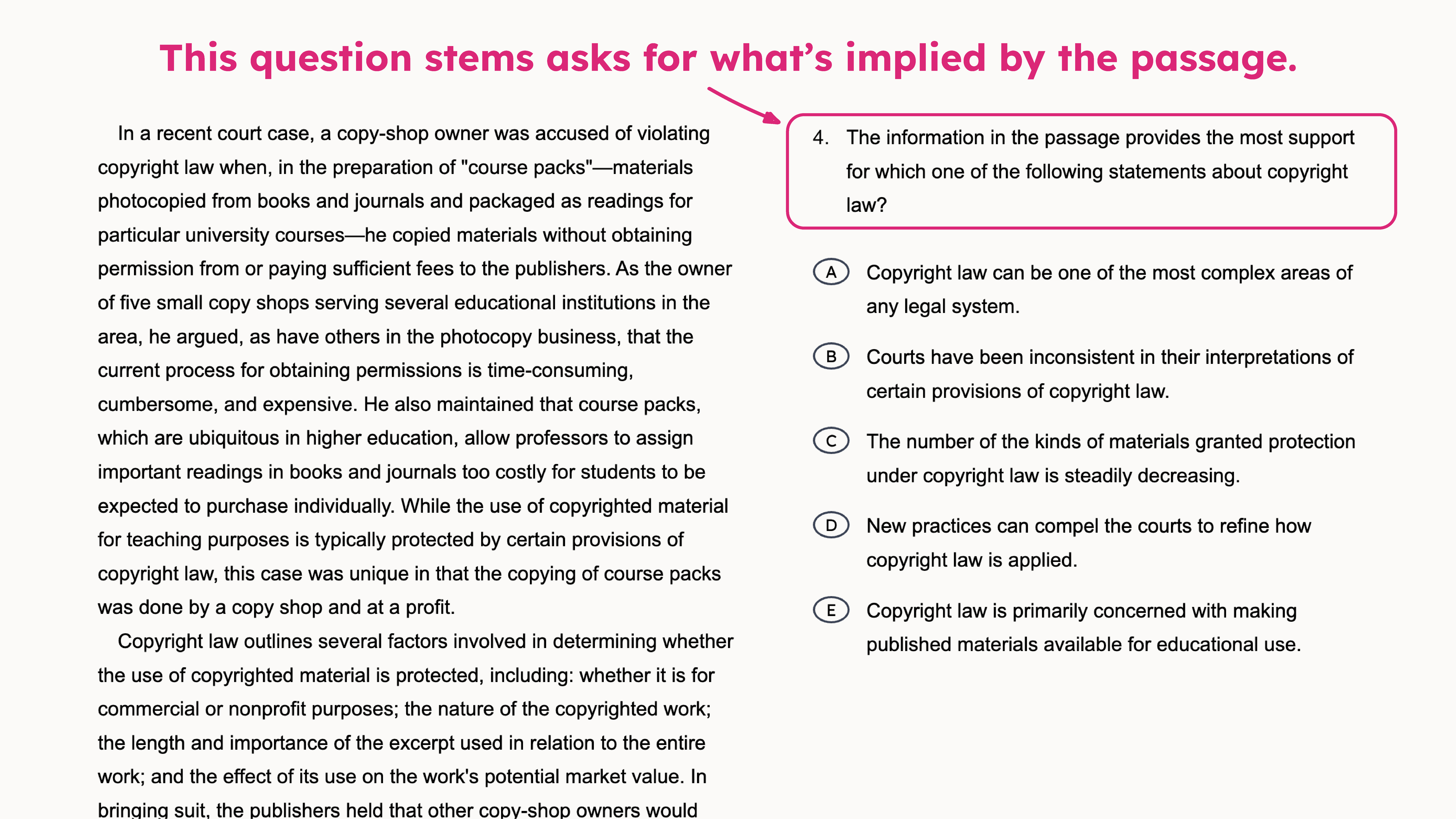
There’s a total of 13 different types of RC question stem.
The only thing we haven’t talked about yet are the answer choices, so let’s do that.
The Answer Choices
As with LR, every RC question has five answer choices. Students often feel that RC answers are subjective, and that more than one answer choice would be a suitable response to the question stem.
But, again, there is only one right answer. An attractive wrong answer choice might be correct except for one small detail—often, a misrepresentation of the passage. If two or more answer choices look right, it’s because you’re misreading something, either in the passage or right there in the answer choices.
Try a Reading Comprehension Passage
Below is a full set of questions for a single RC passage for you to try out yourself. The range of question stems you’ll see, and the difficulty level of the passage and questions, is fairly representative of what you’ll encounter in RC. Note, though, some subjects and questions are more challenging.
Even More Sample Questions
By now, you’ve seen the main LR question types and worked through a full RC passage. If you’re ready to go further, you can sign up for a free 7Sage account for hundreds more free questions, detailed explanations, and performance analytics that pinpoint your weaknesses.


